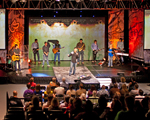From mega-churches to small town congregations, the video-venue concept is becoming a staple of church growth. For those not “in the know”, a “video-venue” is a church meeting where parts of the service (typically the sermon or message) are piped in via video signal and projected on a large screen, while other parts of the service (like the music or announcements) are done live.
Since the sermon is filmed in the “main sanctuary”, it can be broadcast to different rooms within the same church building (onsite video-venues) or to campuses across town, out of state, and beyond (offsite video-venues). As a devoted church member and as an acoustical consultant, I have experienced many different types of video venues firsthand, and I have found a common thread of acoustical “challenges” they typically face. If you are planning a video-venue or portable church ministry, here are some important items to consider before selecting your new space…
- Regardless of the existing use of the space, try to visit during a time when it is being used by the regular tenant. The space will feel and perform very differently acoustically when a selection committee of 5 or 6 people walk through an empty room versus a room filled with people. Get a feel for yourself and see if the room actually works with large groups.
- Have your site visit conversation on the floor of the room while the space is occupied. One indicator that the room may be too reverberant for you is how well this conversation goes. If you find yourself constantly leaning in to hear, having to focus extra hard, raising your voice above normal conversational levels, or even excusing yourselves to the lobby or a separate space to continue the conversation, consider it a big red flag.
- During your site visit, ask the owner to turn the mechanical systems on at full capacity. Mechanical systems can present a major noise source within the space; systems that cycle on and off will also present additional challenges that may interrupt or distract from the worship experience.
- Understand that curtains will rarely fix the acoustical problems… I can’t tell you how many times I’ve heard, “we’ll just hang a few curtains and things should work out.” The reality is that a space that is already lacking acoustical treatment will most likely need a LOT of treatment. As a quick example, a standard sized single court gymnasium with no acoustical treatment could need more than 7,000 ft2 of heavy curtains. Even then, the room will likely be “boomy” since curtains are not efficient low frequency absorbers. Hanging a “few” curtains or banners will not make the space perfect.
- Finally, look to a qualified acoustical consultant. While we often provide solutions to problems or design new spaces, we are also available to do site visits and help in the site selection at a relatively low cost. Try to find a consultant with a lot of field experience and who understands the church environment and can quickly assess your acoustical needs; a skilled acoustician can quickly recognize problematic spaces and provide some useful guidance during your site selection.

Nice post, I agree it make a big difference to acoustics when the audience are present.